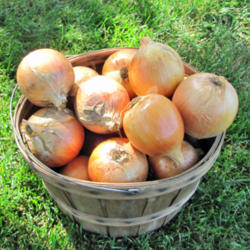
Fall is usually a time of harvesting the last of the vegetable crops and cleaning up. But in warm areas, it's just the beginning for some crops. Now is the time to be planting garlic, overwintering greens such as spinach, arugula, and kale, and the queen of fall: onions.
Short Day or Long DayOnions are generally grouped in two categories: short day and long day. Long-day onions, such as 'Walla Walla' and 'Yellow Spanish', form their bulbs in response to long day lengths. They are traditionally planted in spring in the North to mature in summer.
Short-day onions, such as '1015Y Granex' and 'White Bermuda', form their bulbs in response to short days. They are traditionally planted in fall in the South to grow through the winter and bulb up in late spring while the days are still short. There is a new third class called intermediate-day onions. Intermediate varieties, such a 'Candy' and 'Super Star', aren't day-length sensitive and can be planted in spring in the North and in spring and fall in the South.
Planting Onions in FallIf you live in USDA zones 7 or warmer, now is the time to plant short-day or intermediate-day onions. Before planting, prepare the ground ahead of time. Since onions like a well-drained, crumbly, fertile soil, raised beds work well. Work a 2-inch layer of compost into the bed before planting. At planting, apply a complete fertilizer, such as 10-10-10, at 1/2 cup per 20-foot row. Although onions are heavy feeders, save most of your fertilizing until spring when the bulbs begin to form.
You can start onions from seed or transplants. Start seeds in flats sown indoors under lights. After growing them for 6 to 8 weeks indoors, transplant the young seedlings outdoors into their beds spaced 4 inches apart with 12 inches between rows.
Onion CareKeep the bed moist and weed-free; onions need a constant supply of water and minimum competition from weeds. Mulch transplants with a 1- to 2-inch-thick layer of finely chopped hay or leaves to conserve moisture and help keep weeds down. In colder areas where you're pushing the limit of overwintering, the plants may need protection. Place a floating row cover over transplants in November to help keep winter minimum temperatures above 0° F.
Once new growth starts in spring, side-dress twice, one month apart, with 1/4 cup of alfalfa meal per 10-foot row. Avoid sulfur-based chemical fertilizers, such as ammonium sulfate, and don't apply fertilizer within 30 days of harvest, or you may increase the onion's pungency.
For more information on onion planting and care go to the Virtual Vegetable Guides at www.willhiteseed.com/store/asp/guides.asp
Come spring (April to June), wait until most of the tops have naturally fallen over to harvest your onions. Let them cure a few days in the sun, then store them in a cool basement. Many of the short- and intermediate-day varieties generally don't store well, so eat them as soon as you can.
Question of the WeekQ. When should I dig my sweet potatoes? The plants are still growing, but I can see parts of the potatoes bulging up from the ground.
A. In general sweet potatoes should be harvested as soon as the leaves start to yellow, but before frost. The longer sweet potatoes are allowed to remain in the ground, the larger the tubers and the higher the vitamin content. However, if frost blackens the vines, the tubers can quickly rot.
Dig tubers on a sunny day when the soil is dry. Tubers can grow up to a foot away from the plant, so dig carefully so you won't damage the thin skins. Dry tubers in the sun for several hours, then move them to a well-ventilated spot and keep them at 85° to 90° F degrees for 10 to 15 days to cure them. Properly cured and stored sweet potatoes will keep for several months.
 Charlie Nardozzi is an award winning, nationally recognized garden writer, speaker, radio, and television personality. He has worked for more than 30 years bringing expert gardening information to home gardeners through radio, television, talks, tours, on-line, and the printed page. Charlie delights in making gardening information simple, easy, fun and accessible to everyone. He's the author of 6 books, has three radio shows in New England and a TV show. He leads Garden Tours around the world and consults with organizations and companies about gardening programs. See more about him at Gardening With Charlie.
Charlie Nardozzi is an award winning, nationally recognized garden writer, speaker, radio, and television personality. He has worked for more than 30 years bringing expert gardening information to home gardeners through radio, television, talks, tours, on-line, and the printed page. Charlie delights in making gardening information simple, easy, fun and accessible to everyone. He's the author of 6 books, has three radio shows in New England and a TV show. He leads Garden Tours around the world and consults with organizations and companies about gardening programs. See more about him at Gardening With Charlie.